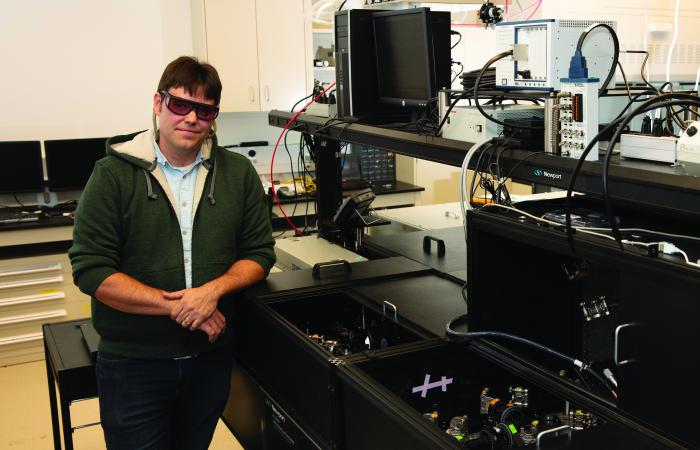A conversation with spectroscopist Ben Doughty
What does a high school grad do when his family threatens to make him pay rent? For ORNL spectroscopist Ben Doughty, the answer was, go to college.
Doughty avoided the threatened stay-at-home tax by enrolling at the University of Florida, where he discovered a talent for chemistry. He followed up his undergrad career with a Ph.D. from the University of California at Berkeley, a postdoctoral position at Columbia University and a Wigner fellowship at ORNL.
Doughty won a 2018 Early Career Research Program award from DOE’s Office of Science for his proposal “Chemical Organization, Structure and Dynamics at Complex Liquid-Liquid Interfaces: Mechanistic Insight into Selective Solvent Extraction and Self-Assembly.” We talked with him about the project and about what drew him to a career in science. This is an edited transcript.
1. Why is the interface between liquids important?
There is a lot of interesting chemistry that happens at that interface. What we are interested in is really understanding how molecules or atoms or individual ions are transported across the interface. This has applications in nuclear waste cleanup and separating materials for purification processes. There are lots of technological reasons why you would want to separate two things from each other, and a liquid-liquid interface happens to be a very good way to do that. The molecular machinery does a very efficient job, but we don't quite understand how it works.
2. How will you go about understanding the liquid-liquid interface?
I specialize in a field of laser spectroscopy called nonlinear optics using techniques called sum-frequency generation and second harmonic generation.
We take two very intense, very short laser pulses that last 50 femtoseconds—that's 50 millionths of a billionth of a second, so you have an immense amount of energy crammed into a very short time window. When you overlap two pulses at a sample, you can generate new colors, where you add and subtract the individual laser frequencies inside of those pulses. And whenever there's a molecule at an interface that absorbs light in one of those laser packets, you get an enhanced signal. So what you end up getting is a spectrum that now reports on just the interface, just the surface.
The tools that we developed in the lab are really designed to target complicated interfaces, and a liquid-liquid interface is one of the more complicated things you can look at. It sounds simple—just oil and water—but there are a lot of subtleties that are very poorly understood.
We are also bringing in neutron scattering measurements to give complementary information. With the nonlinear techniques that we use, we can get information about orientation, hydrogen bonding and chemical speciation in the molecular plane. With neutron scattering, you get information about how molecules are ordered out of the plane, above and below.
3. What will we be able to do with a better understanding of the liquid-liquid interface?
Right now our understanding of an interface for separations purposes is based on a thermodynamic perspective—you look at how you lower the overall energy of the system. That's a time-averaged perspective.
What we are looking to do is understand how these processes occur in situ; and then on the ultrafast time scale, how do they hold onto molecules, how do they dissipate energy in very efficient ways.
The idea is that if you understand those time-dependent kinetic aspects of the chemistry, you can then design molecules that will better funnel energy into keeping a bond intact; or you can better design molecules that will aggregate or self-assemble in ways that target a molecule that you want selectively.
4. What attracted you to a career in science?
The first time I was really interested in science, I was at a diner with my dad, and he was telling me about relativity, of all things. We were just chatting, and he told me about a book, A Brief History of Time, by Stephen Hawking, that I then read, and it got me interested in physics.
Then I went to college, mostly because I didn't want to pay for rent. If I didn't go to college, he was going to make me pay rent at home, so I went and signed up for college. I did that, and I was good at chemistry, and I just kind of kept going. It was one of those things that, once that ball got going, it was fairly easy to stay in it.





